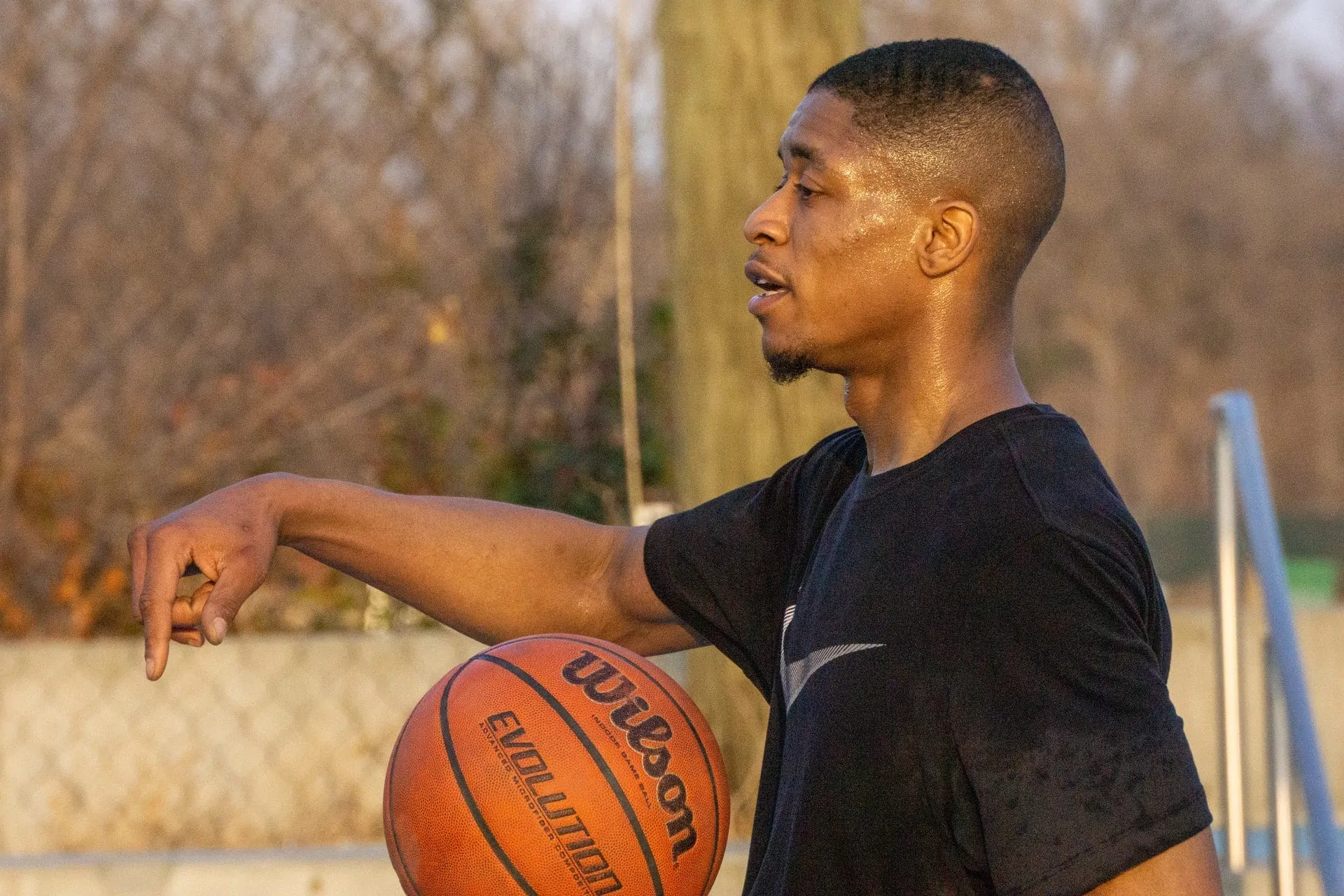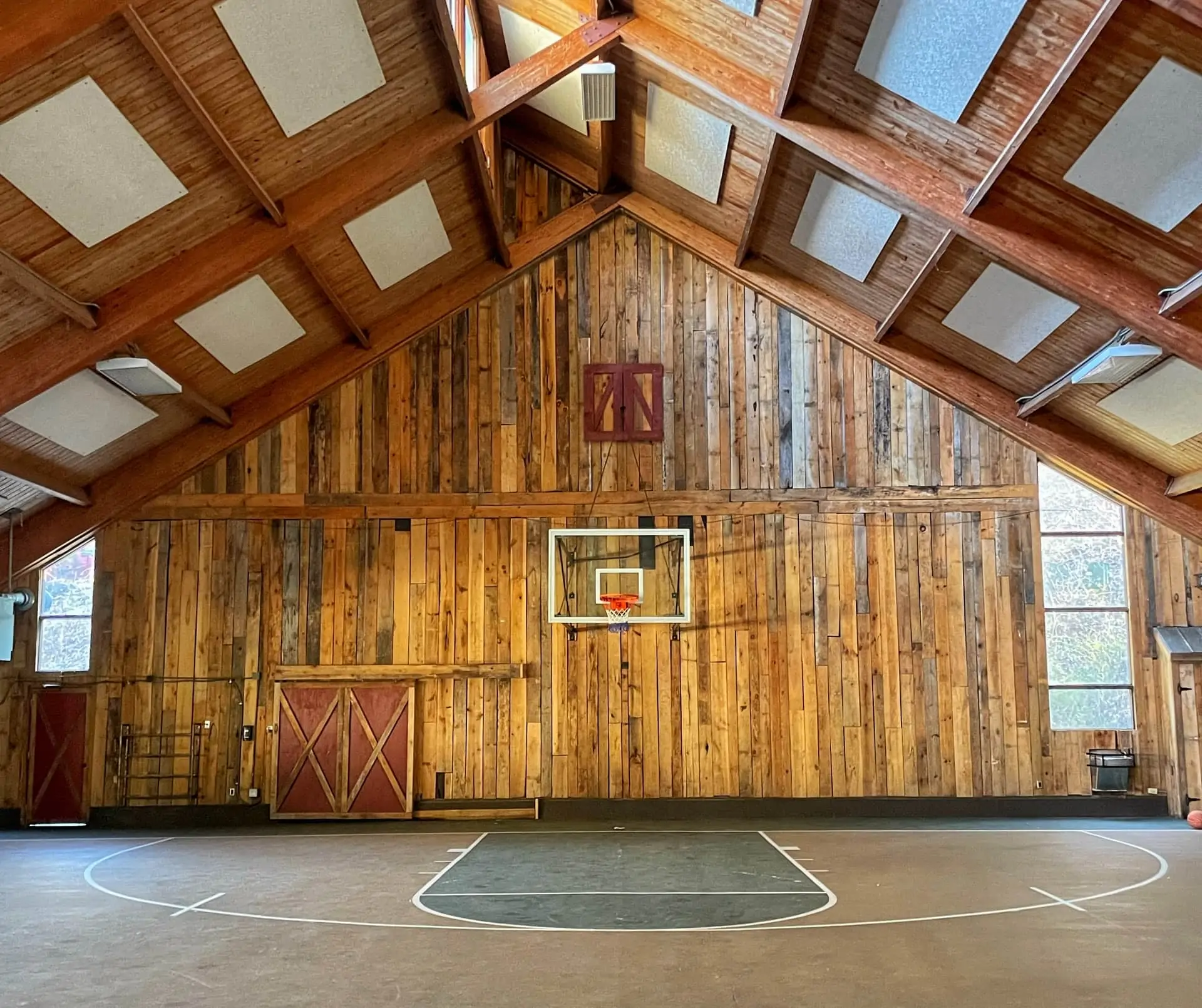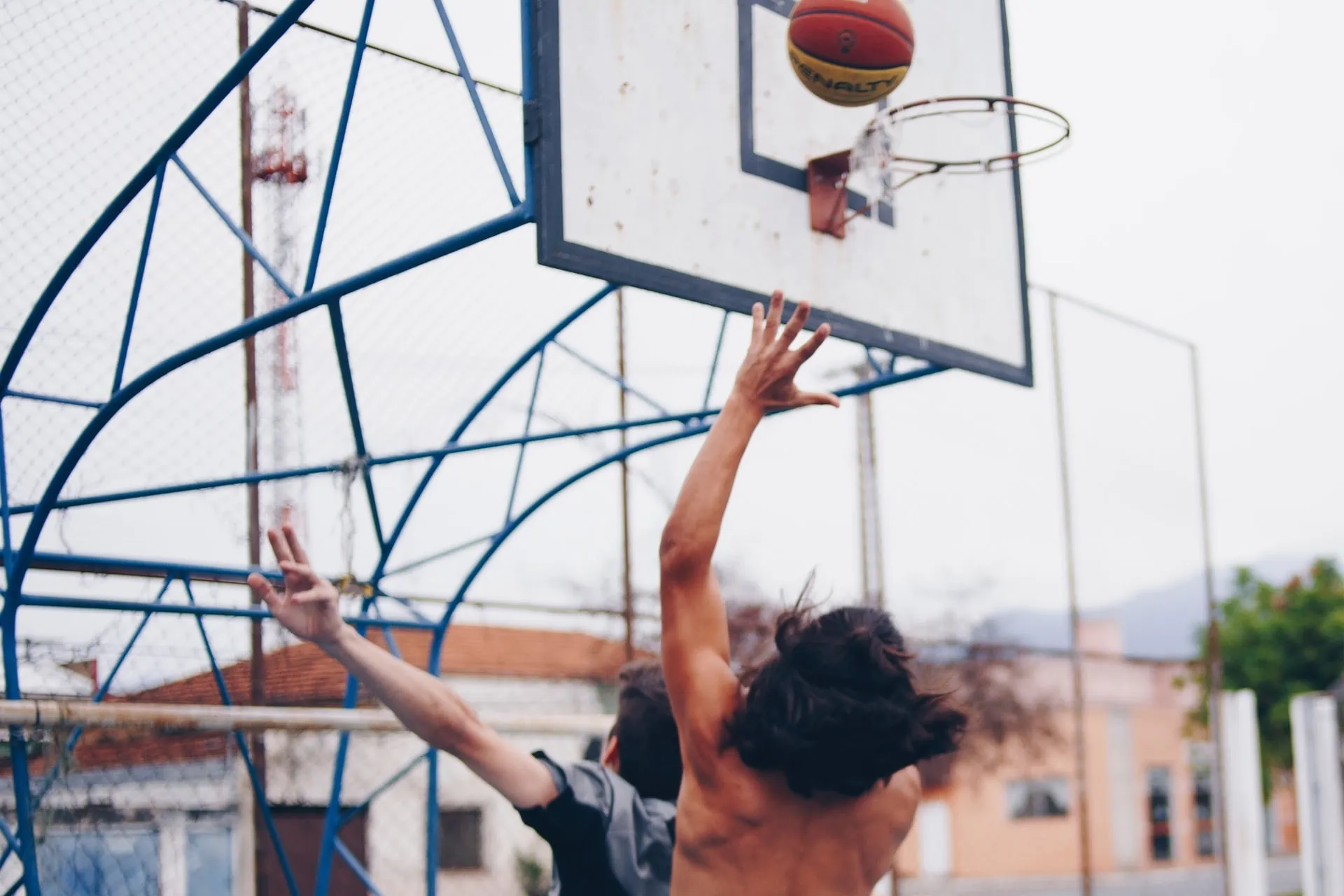From Michael Jordan’s elegant pull-up jumpers to Stephen Curry’s quick-release three-pointers, there are plenty of different ways to score in basketball. And for a lot of people, this variety is where the beauty of the game truly lies. However, there’s one scoring option that is slowly fading into irrelevance for a lot of younger players – the post play. So, what is post play in basketball exactly? Here’s an in-depth look.
For many players who grew up playing or watching the game in the 2010s and beyond, the post-play isn’t as attractive or as prestigious as it once was. Players like Stephen Curry, Damian Lillard, Trae Young, and others have made working beyond the three-point line an extremely popular way to play.
So, what is it about post play that was so attractive to players back then, and why does it seem that it has lost its luster in today’s game?
 What Does Post Play Mean in Basketball?
What Does Post Play Mean in Basketball?
As the name suggests, post-play typically entails playing within or at least near the post. Post players, therefore, often find themselves with the ball near the basket. It’s an attractive spot on the floor to start an offense, as shots taken near the rim are generally more likely to fall in than those taken beyond the 3-point line.
One common misconception about post play is that most players need to have their backs to the basket. However, some of the most prolific post players, such as Duncan and Garnett, often initiate their post play with a triple-threat position.
The critical thing to remember about post play is that it’s initiated from anywhere near the shaded area from the baseline extending all the way to the free throw line.
 Why Is It Called The Post in Basketball?
Why Is It Called The Post in Basketball?
People well-versed in basketball lingo have a lot of names for the post. It’s even quite common to hear coaches interchange the different terms in one sentence, which can be a problem for some beginners. To help you out, we’ve listed a couple of the most utilized terms for the post in basketball jargon:
- The Key
- The Paint
- The Shaded Area
- The Restricted Area
- The Lane
When coaches talk about the post, they mean the area in the basketball court directly underneath the rim outlined by the baseline, the free throw line, and the two-lane lines on the side parallel to the sidelines creating a rectangle in the middle of the frontcourt. These lane lines are why the post is also sometimes called the lane.
Depending on the league, the dimensions of the post can differ from each other. For example, in the NBA and FIBA, its width is exactly 16 feet, while the post in the NCAA and other collegiate leagues is limited to about 12 feet wide. There is a semi-circle at the top of the lane with a diameter of 6 feet.
The post is typically painted in a shade distinct from the rest of the playing court, which is where some of its names are derived, such as the shaded area and the painted area.
The color shift is important as it’s a tool that referees can utilize to monitor the 3-second violation. It stipulates that offensive players can stay in the post no longer than 3 seconds to avoid large players from gaining an unfair advantage by camping too close to the basket.
The key is perhaps one of the more perplexing names for the post, as it does not resemble a key in any way. However, with a bit of research, you’ll find that the post used to resemble a key because the lane lines used to be much closer than they currently are. The semi-circle at the end of the lane lines even looks like the key’s bow.
 The Difference Between The Low and High Post
The Difference Between The Low and High Post
Coaches typically separate the post into two different sections – the high post and the low post. These sections generally refer to how far an offensive player is to the basket.
Post-play can start in both areas. However, the skills required to operate in these two different areas successfully can vary greatly.
What is the High Post in Basketball?
The high post is the area along the free-throw line, including the entirety of the semi-circle at the top of the key and areas lateral to it called the elbow.
What is the Low Post in Basketball?
On the other hand, the low post is an area that is much closer to the basket. Generally, the low post refers to the area adjacent to the lane lines nearest the basket up to its halfway point on either side.
 What is a Post Player?
What is a Post Player?
On offense, post players typically lurk near the post while cutting and screening for teammates. If the coach calls a post play, the post player makes it their goal to receive the ball near the post in a position where they can score.
Since it’s usually crowded in the post, the post players are typically tall and strong, capable of keeping multiple defenders from intercepting an inside pass. However, there are some instances when a smaller player can choose to play in the post in the hopes of exploiting a mismatch.
Post players also usually have their backs to the basket in a post-up position to protect the ball from defenders attempting to steal it. However, some prolific post players like to change up their post play from time to time by starting their moves in a triple threat position.
On defense, post players must contest and prevent the opponent’s post players from getting inside the paint. This job, therefore, requires strength to prevent the other team from bullying their way into the post and agility to stop them from weaving through traffic.
 How to Improve on Your Post Play
How to Improve on Your Post Play
As an offensive player, operating in the post requires a great deal of skill. The most straightforward skill to develop is scoring, but receiving a pass and getting open for a shot are post-player skills that are just important to hone.
So, for players trying to develop their post play, here are some areas of the game that would do a great deal of benefits:
1. Mid-range Shooting and Inside Finishing
The point of working in the post is that it’s much easier to drain a basket when you shoot closer to the rim. For a post player, therefore, it’s crucial to hone inside and mid-range scoring techniques.
Tall post players who like to work in the low post like Kareem Abdul Jabar utilize the hook shot. It would also be beneficial for post players to learn how to finish a layup with contact, as post play is usually the most physical part of the game.
Players who like to operate in the high post, on the other hand, could do well to practice some fadeaway mid-range jump shots like Michael Jordan and Kobe Bryant. Quick pull-up jumpers and floaters should also work well for players looking to be effective scorers in the high post.
There are plenty of moves and post-play drills players can practice to improve their scoring chances. The ever-reliable up and under move, for example, can be an incredible offensive weapon for both tall and short post players.
Here are a couple more scoring techniques that post players need to concentrate on:
- Turn-around jump shots or fadeaway shots from a post-up position
- Stationary and running jump hooks to the lane
- Pull up jump shots from the elbow and the free throw line
- Layups and teardrops going to the basket
2. Foot Work
The post is usually the most crowded spot on the floor as it’s an area where the offense has the highest chance of making a basket. The defense, therefore, tends to focus their efforts in this area. Post players must be able to weave through the crowded lane to find an open spot to either catch an inside pass or to try to make a field goal.
Developing solid footwork should help players immensely in navigating the intricacies of post play. It could allow players to either avoid the defense for an open shot or manipulate them to give you an open lane to the basket.
Post Play Footwork Techniques to Improve:
- Pivot – Great post play is usually predicated on the ballhandler’s ability to utilize the pivot. It’s a technique that can help players maneuver around defenders with ease. Post players with some degree of quickness can often get themselves open in the attacking lane or the low post with some clever use of the pivot.
- Drop Step – For tall and powerful players, the drop step is perhaps the single most important footwork technique to master. It doesn’t require a lot of quickness to execute successfully. With just a little bit of force, a strong post player like Shaquille O’Neal can find themselves directly next to the rim for a dunk or a lay-in using a drop step.
- Jab Steps – A successful pivot is usually enough to get open for quick players. However, if that doesn’t work, using the pivot with a few jab steps and cross-steps can help ball handlers shake off their defenders for an open shot or layup. The key here is knowing how to read the defense on how they react to your moves.
3. Strength
Both low post and high post operators need to build some strength as it’s a strategically important region in the court for the offense. Post players, therefore, would often find themselves jostling for position in the post.
Even when post players have already received the ball, defenders would still try to push the ball handler away from the post to reduce their chances of scoring. Referees are also a bit more lenient in the post for both teams. Post players, therefore, would do well to build some strength in their lower bodies to be able to absorb the impact and maintain balance when they’re in a post-up position.
 3 Effective Post Moves in Basketball
3 Effective Post Moves in Basketball
There are two main ingredients of a good post move – the footwork and the finish. A post player who has refined both will be able to stand out and become a crucial part of their team’s roster.
Luckily, there are a lot of great players that had come before that had incredibly refined post play that we can copy, master, and eventually, make even better. Here are a few of the most effective post moves to help you become a better post player.
1. Post Hook
The hook is probably one of the most underrated shots in basketball. It’s tough to block even if the post players give up a little height over their defender.
When combined with a drop step, it can become even more effective. Drop steps, especially for strong post players, can create a little bit of space for players to launch a hook.
2. Post Up Fadeaway
The only downside with the post hook move is that it’s challenging to hit the shot as players get farther away from the basket. Post players who operate in the high post, therefore, might not utilize it as much as they want to.
To work around this, high post players tend to use the post-up fade away. For tall shooters like Kevin Durant, this move can be the ultimate scoring weapon as it gives players the opportunity to score close to the basket while protecting the ball from steals and blocks.
It’s not just a high post-move. It’s an excellent low post weapon too, especially when most players are forced to shoot over defenders with a significant height advantage over them.
3. Post Spin
Unlike the post-up fadeaway and the post hook, which are two-step moves, the post-spin needs players to string together three moves to execute correctly.
After receiving the ball in a post-up, players must pivot to a face-up position. Then, after probing the defense with a jab or cross-step, a well-placed spin move in the other direction can be used to open up a driving lane to the basket.
It’s a complicated move, but it can be effective when post players are under tight coverage.
 How to Become a Better Post Player
How to Become a Better Post Player
You may already have the skills and the moves to become a good post player. However, playing in the post can be a complex battle of wits between offense and defense. Because of this, tiny little details can spell the difference between a good post player and a great one.
Here are a couple of pointers on how to get to the next level:
Use the Hop Step When Receiving the Ball – Having options is key in any situation in basketball. This is no different if you’re playing in the post. However, some players, even professionals, may already be limiting their options even before they post up by receiving the ball with a pivot foot already established. By simply using a hop step and landing on both feet while receiving a pass in the post, players can have the luxury of choosing their pivot foot later. This would allow them to have more options on how to commence with their post play.
Practice Reading Your Defenders – Effective post players must be able to react depending on the situation on the court. It’s essential, therefore, to probe your defenders and see how they respond to you. Convincing jabs and cross-steps are critical in this regard. Shot fakes can also throw them off balance a little bit. Only then can post players know how to react and score a bucket. Talented post players can also use their ability to read defenders to act as playmakers in the post. The MVP for the 2020-2021 season Nikola Jokic, for example, has made the post his personal playmaking area.
 Who Is the Greatest Post Scorer in the NBA?
Who Is the Greatest Post Scorer in the NBA?
Post players, whether they’re guards or centers, have one of the greatest players in NBA history to look up to – Hakeem Olajuwon. While he wasn’t the most prolific post scorer, Hakeem displayed an arsenal of post moves still studied by players today. He was a center who moved like a guard, which was not a common type of player in any era.
Olajuwon even had one of the game’s most spectacular post moves named after him – the “Dream Shake.” It’s a move that involved a series of head fakes, jabs, and spin moves that left defenders in its wake. And what’s even more amazing about it is that it’s just as effective when smaller guards use it.
Kobe Bryant even famously signed Hakeem up to teach him how to become a better scorer in the post. At this point in his career, Bryant raised his scoring output and even won two championships in the process.
Wrapping Up: What is Post Play in Basketball?
While post play in basketball has waned in popularity in recent years, the sentiment that it is not worth paying attention to for both players and coaches is clearly misguided. Post-play, to be more accurate, is evolving.
Post players no longer camp in the post, waiting for a pass like Wilt Chamberlain and Shaquille. Instead, post players have become more dynamic in looking for open spaces in the post where you can execute your moves.
So, whether you’re a guard, a center, or a forward, you’d do well to give your post-play some attention as you develop your game. It’s a spot on the floor that can unlock a lot of options for you and your team.
Did you enjoy this post? Then you’ll love the other basketball FAQ articles. Check them out below:
> What are the 5 Basic Skills of Basketball?
> What Basketball Position Are You?
> What Does a Shooting Guard Do in Basketball?
Want to get better at basketball?
Join our newsletter & get our comprehensive
101-page basketball guide.
Become a better baller today 👇


 What Does Post Play Mean in Basketball?
What Does Post Play Mean in Basketball? Why Is It Called The Post in Basketball?
Why Is It Called The Post in Basketball?
 The Difference Between The Low and High Post
The Difference Between The Low and High Post
 What is a Post Player?
What is a Post Player? How to Improve on Your Post Play
How to Improve on Your Post Play
 3 Effective Post Moves in Basketball
3 Effective Post Moves in Basketball How to Become a Better Post Player
How to Become a Better Post Player Who Is the Greatest Post Scorer in the NBA?
Who Is the Greatest Post Scorer in the NBA?

